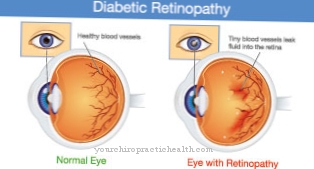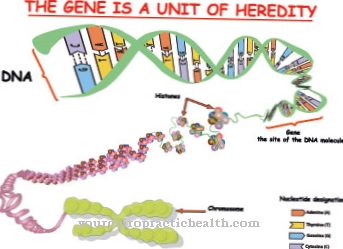The Sickle cell anemia (technical language: Drepanocytosis) is an inherited disease of the red blood cells. A distinction is made between a severe homozygous and a mild heterozygous form. Since the heterozygous sickle cell anemia confers a certain resistance to malaria, it is v. a. Widespread in malaria risk areas (Africa, Asia and the Mediterranean region).
What is sickle cell anemia?

© DAntes - stock.adobe.com
The Sickle cell anemia is one of the hemoglobinopathies (disorders of the red blood pigment hemoglobin). Hemoglobin is a complex protein made up of 4 subunits that gives the red blood cells (erythrocytes) their color and binds oxygen for transport through the organism.
The changed hemoglobin (HbS) in sickle cell anemia tends to crystallize out when there is a lack of oxygen. As a result, the erythrocytes become sickle-cell shaped and clog vessels, perish or are broken down prematurely. Sickle cell anemia is therefore characterized by hemolytic anemia and circulatory disorders.
causes
Of the Sickle cell anemia is based on a gene mutation that leads to the replacement of a single amino acid in the amino acid sequence of the hemoglobin β subunits. The disease is inherited as an autosomal codominant trait.
Heterozygous patients have one healthy and one diseased allele; in them only about 1 percent of the hemoglobin is changed. Homozygous patients with two mutated alleles only have abnormal hemoglobin, which leads to a much more severe course of the disease. Even in the healthy organism there is a physiological lack of oxygen in small vessels, which causes the healthy hemoglobin to release its oxygen here.
In homozygous sickle cell anemia, even this physiologically low oxygen partial pressure leads to deformation of the erythrocytes. They clog the vessels and tend to dissolve. The hemoglobin released in the process binds nitrogen monoxide - an important vasodilator (vasodilator). The vessels are not only clogged, but also narrow. The closure of many small end arteries in sickle cell anemia leads to circulatory disorders and damage to various organ systems.
Symptoms, ailments & signs
The symptoms of sickle cell anemia can vary in severity, depending on whether the person affected is a homozygous or heterozygous carrier of the responsible gene mutation.
In heterozygous carriers there are generally no symptoms in general. Occasionally, however, hemolysis can occur. Many red blood cells are suddenly broken down, which can put a lot of strain on the kidneys in particular and lead to a temporary lack of oxygen. This type of hemolysis can be life threatening. Such a disintegration of red blood cells in heterozygous genetic material occurs in response to a lack of oxygen or certain drugs.
Homozygous carriers, on the other hand, show the first symptoms just a few months after birth. Severe attacks of pain can occur as a result of a lack of oxygen supply. Blood vessels are also blocked more frequently, which can lead to both small and large heart attacks. Tissue death occasionally occurs on parts of the body that are not supplied with oxygen. Bone pain is very common.
People suffering from sickle cell anemia are also more susceptible to infection and often complain of fever. The tendency to jaundice is greatly increased, which is due to the increased breakdown of destroyed erythrocytes. In addition, all symptoms of anemia are shown. This leads to paleness, light-colored mucous membranes, difficulty concentrating, a feeling of weakness and, in some cases, shortness of breath.
Diagnosis & course
In the first months of life, each person produces a special fetal hemoglobin, which is the genetic defect of the Sickle cell anemia does not affect. The disease is therefore only noticeable from the 6th month of life when the adult hemoglobin comes into play.
In childhood, it is mainly homozygous patients that stand out: They suffer early from painful hemolytic crises. These include hemolytic anemia with paleness, jaundice and weakness, as well as circulatory disorders and multiple small organ infarctions, typically in the brain and eye, in the spleen, lungs, kidneys and heart, as well as in muscles and bones. The skeletal maturity is delayed. A typical symptom is a painful permanent erection (priapism).
The diagnosis of sickle cell anemia is confirmed by laboratory diagnostics, in particular by hemoglobin gel electrophoresis. A genetic test differentiates between homozygous and heterozygous diseases. Only half of the homozygous sufferers reach the age of 30. Lung infections are the leading cause of death because of the damaged lungs.
In contrast to the severe form of the disease, heterozygous sickle cell anemia can remain normal for a long time. The first hemolytic crisis may not occur until there is an unphysiological lack of oxygen, e.g. B. under extreme athletic stress or when staying at high altitude.
Complications
Sickle cell anemia can result in complications that can be severe. The effects can be seen in the case of a blockage of vessels in different areas of the body on the sickle cells. Doctors then also speak of a sickle cell crisis.
If small vessels in the legs are blocked by sickle cell anemia, there is a risk of skin ulcers developing on the legs. Seizures are a neurological complication. In severe cases, cerebral hemorrhages or the patient slipping into a coma are also possible. The reason for this are blockages within the brain that require immediate therapy.
The formation of gallstones is also one of the sequelae of sickle cell anemia. They are not the result of a vascular blockage, but are caused by the breakdown of red blood cells (erythrocytes). Bilirubin is one of the by-products of these disintegration phenomena. If the bilirubin level in the blood increases, the risk of gallstones forming, also known as pigment stones, increases.
In males, priapism can sometimes be seen in sickle cell anemia. This is a painful and permanent erection. It comes about by blocking the blood vessels inside the penis. Without treatment, priapism can cause erectile dysfunction.
Blindness is a dreaded complication of sickle cell anemia. It is caused by blockages in the vessels that are responsible for supplying the eyes. There is a risk of damage to the retina.
When should you go to the doctor?
Only through medical treatment for this disease can further complications and complaints be prevented. A doctor should therefore be consulted at the first signs and symptoms of sickle cell anemia. A doctor should be consulted if the patient suffers from a permanent lack of oxygen. This often leads to severe fatigue or severe confusion, with those affected being sluggish and no longer actively participating in everyday life. Furthermore, severe pain in the head or bones can indicate sickle cell anemia and must also be treated by a doctor.
The patients suffer from an increased susceptibility to infections and also from very paleness or from a high fever. If sickle cell anemia is not treated, the patient's life expectancy is significantly reduced. Sickle cell anemia can be recognized and treated by a general practitioner. A visit to a specialist may also be necessary for treatment. The further course of sickle cell anemia also depends heavily on the exact type of disease.
Treatment & Therapy
A causal therapy against Sickle cell anemia does not exist yet. The only hope of a cure lies in bone marrow transplants - but these are only used in exceptional cases and are still associated with relatively high mortality.
Routine treatment for sickle cell anemia focuses on delaying and relieving symptoms. Particularly in pain crises, patients must be supplied with analgesics. If there is an acute decrease in hemoglobin, partial blood exchange transfusions can be useful. In sickle cell anemia, the spleen is often regressed and does not function properly; the patients then need careful vaccination protection, e.g. B. against pneumococci.
If the spleen does not regress, however, it can also pathologically enlarge (splenomegaly), contribute to worsening anemia and make a splenectomy (removal of the spleen) necessary. In any case, patients with sickle cell anemia should undergo regular routine outpatient examinations outside of a crisis.
prevention
Since the Sickle cell anemia If it is a hereditary genetic defect, there is no prevention against the disease itself. However, heterozygous patients can contribute to a milder course by avoiding a lack of oxygen (e.g. by staying at high altitudes or exercising), paying attention to careful vaccination protection and taking regular medical check-ups.
Aftercare
Sickle cell anemia is considered incurable. Follow-up care for patients with sickle cell anemia focuses on patient education, patient advice (lifestyle), infection prophylaxis and vaccinations, as well as routine diagnostics. The subject of patient training is to inform the patient about the disease itself.
He has to learn that sickle cell anemia can lead to life-threatening symptoms. The warning signs of acutely threatening complications (for example sepsis) should be present to the patient and immediately lead to a consultation with a doctor. It is medically known that patients with sickle cell anemia can experience flare-ups from dehydration, hypothermia, hypoxia, acidosis and infections.
Patient counseling therefore aims to sensitize the patient in his lifestyle so that he can avoid these five factors as far as possible. The time between attacks can be extended. In addition to the general hygiene measures, the daily intake of penicillin is also prescribed by a doctor for patients with sickle cell anemia as an infection prophylaxis.
In addition, to protect against infections, every patient with sickle cell anemia should receive at least one vaccination with 13-valent pneumococcal conjugate vaccine during follow-up. For routine diagnostics, it is recommended that patients with sickle cell anemia be presented to a specialized center at least once a year. There the blood count, blood pressure, pulse rate, liver and kidney values, urine status and protein excretion are to be examined clinically. An echocardiography should also be performed.
You can do that yourself
The disease is usually noticed within the first few months or years of life. Due to nature, at this age the patient cannot help himself or improve his situation. The relatives and legal guardians are therefore responsible for adequately caring for the offspring and working closely with the treating doctor.
Food intake should be optimized to support blood circulation. Specific foods can be used to achieve an absorption of nutrients that stimulate blood formation. In addition, an oxygen-rich environment is particularly important for the infant. The premises must be adequately ventilated and walks in the open air will help to ensure adequate oxygen supply. Even though these measures do not cure the sickle cell anemia, the child's organism can be positively supported.
The child should not be in an environment that contains nicotine or other toxins in the air. Avoid situations of overexertion and heavy strain as well. To protect against infection, it is important to ensure that infection is reduced to a minimum. Leisure activities or sporting activities must also be tailored to the needs of the organism. Sufficient rest and rest are important in order not to unnecessarily strain the immune system.



























